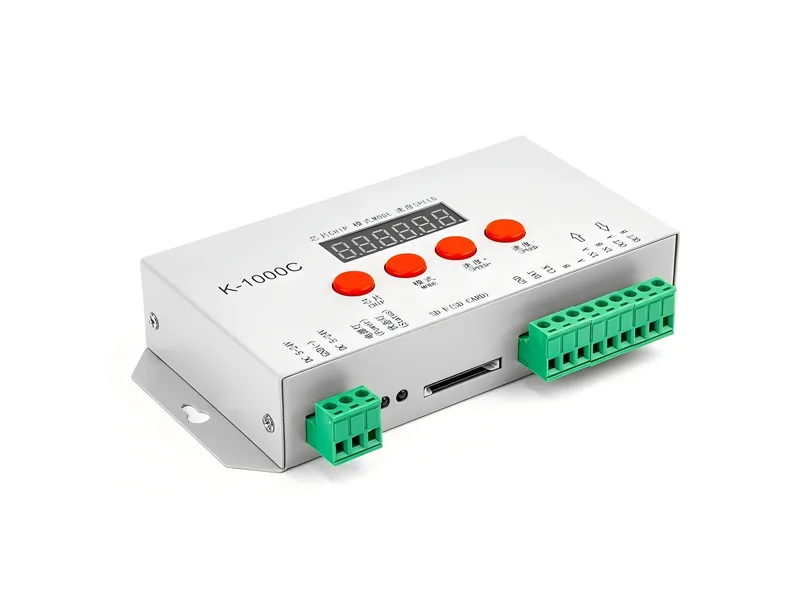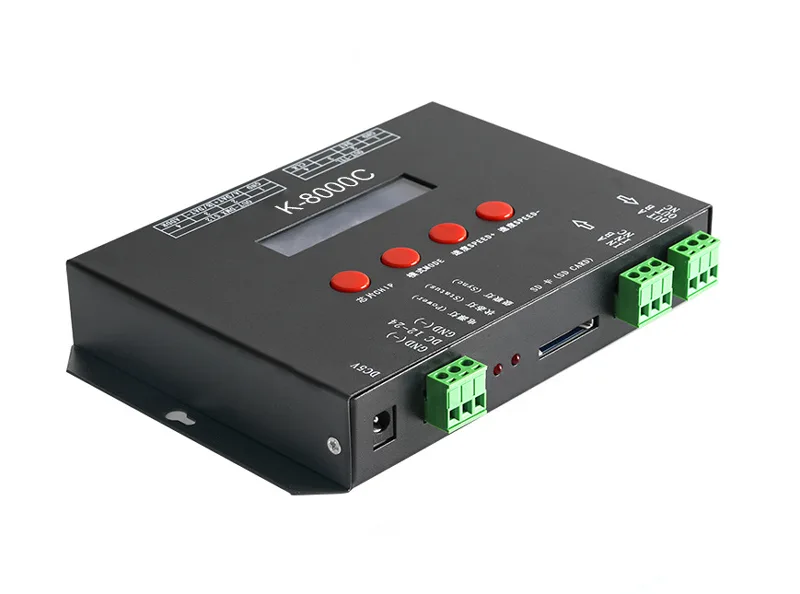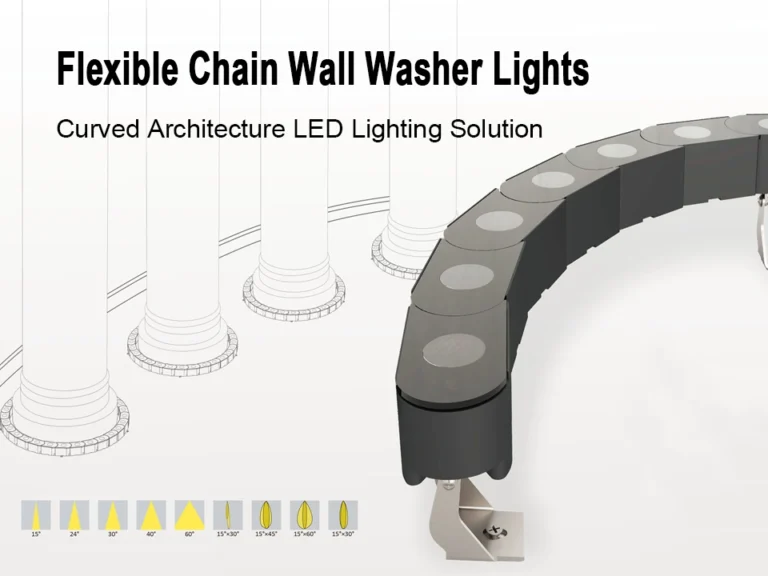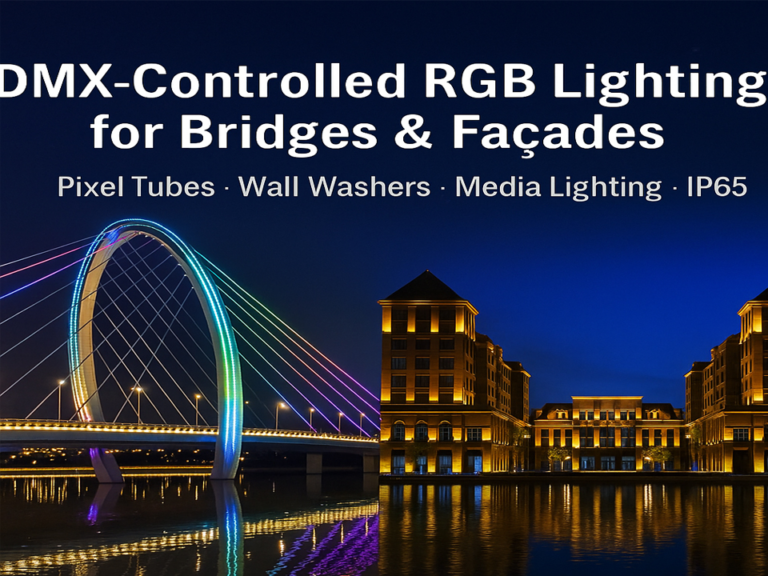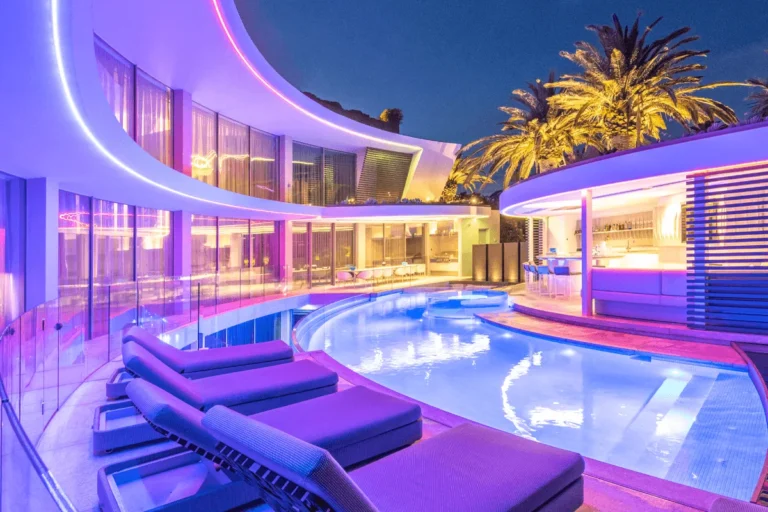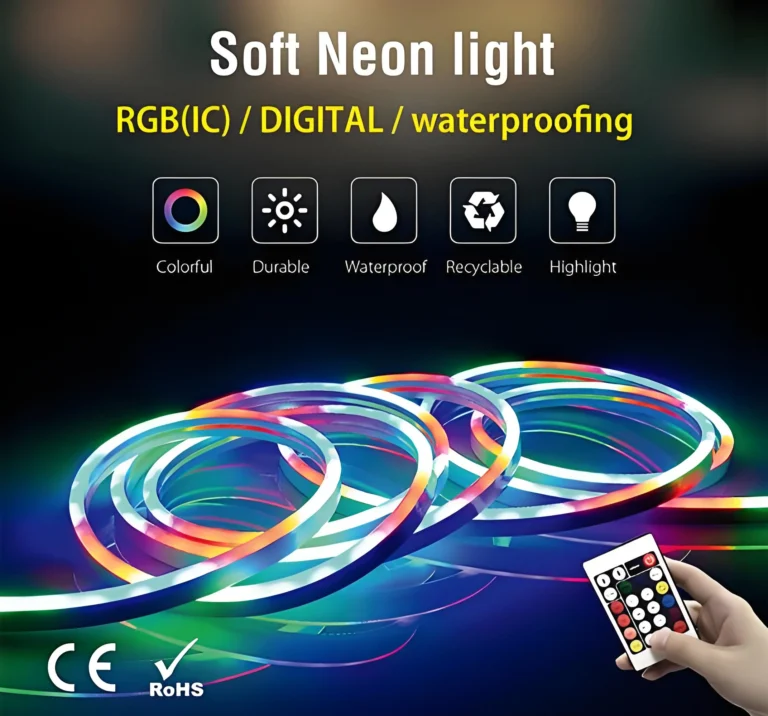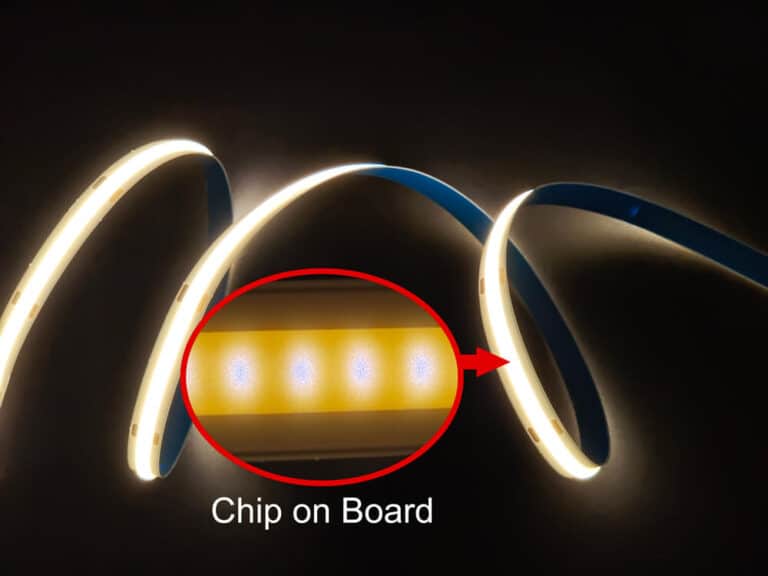Está surgiendo una nueva generación de iluminación arquitectónica LED: El neón LED flex puede encajar perfectamente en las pieles moldeadas de los edificios, consume 85% menos energía que el neón tradicional y, con el sistema de control inteligente DMX512, se pueden realizar 2,56 millones de combinaciones de colores en un solo edificio.
El efecto de luz en espiral de la Shanghai Center Tower y el espectáculo de luces pixeladas de la Guangzhou Tower confirman las infinitas posibilidades de la iluminación digital. Más digna de mención es la integración de la tecnología IoT: el sistema de iluminación del edificio Ping An de Shenzhen puede responder a los datos de PM2,5 en tiempo real y visualizar la calidad del aire urbano con luces y sombras. La iluminación inteligente transforma la fachada del edificio en un lienzo digital, que puede programarse para alternar a la perfección entre escenas como celebraciones navideñas y campañas de servicio público. Las luces del Bosque Vertical de Milán imitan incluso los ritmos de fotosíntesis de los árboles, convirtiendo el edificio en un organismo vivo.
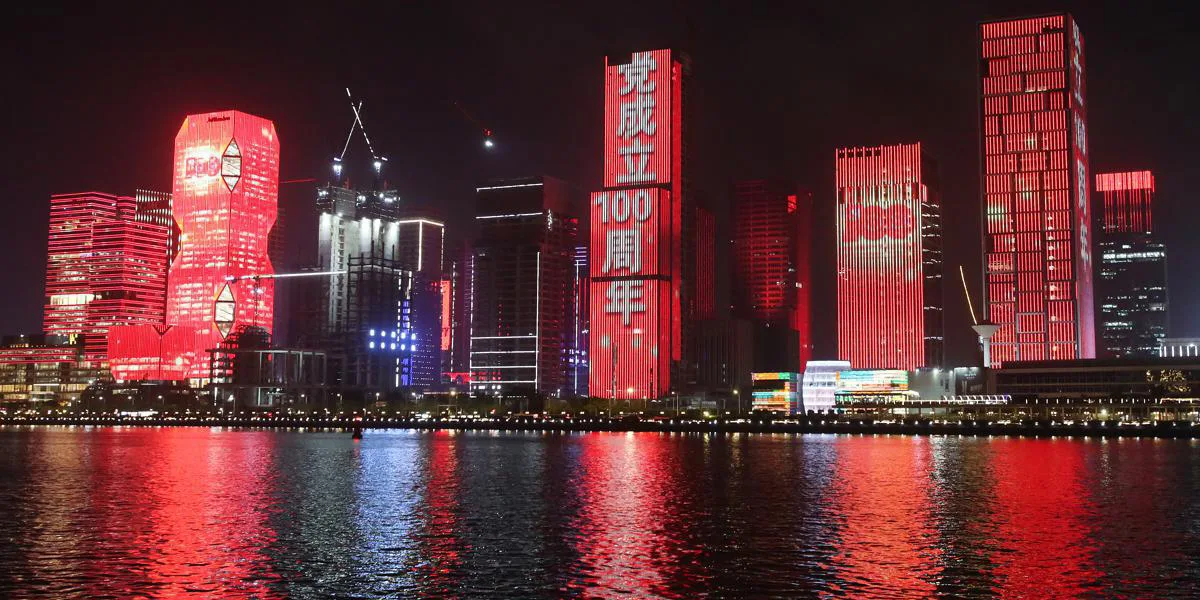
En el diseño de iluminación arquitectónica, el neón Flex LED controlado por DMX está remodelando la estética espacial con su flexibilidad superior y su expresividad dinámica. A través del protocolo DMX512, los diseñadores pueden regular con precisión el brillo, el color y la dinámica de cada tira, lo que permite una creatividad infinita, desde la respiración gradual hasta los ritmos complejos. Esta guía técnica analizará la arquitectura del sistema de iluminación DMX, los puntos de diseño y la selección de productos de los equipos convencionales. Espero que la lea para ayudarle y agilizar la puesta en marcha de su proyecto.
Ventajas del protocolo DMX512 en iluminación inteligente
El protocolo DMX512 consigue un control luz a luz a través de 512 canales independientes, que pueden controlar con precisión parámetros multidimensionales como el color, el brillo, los efectos dinámicos, etc., para satisfacer los estrictos requisitos de los efectos de luz complejos en escenas como escenarios y fachadas de edificios.
Su velocidad de respuesta de milisegundos garantiza el funcionamiento sincronizado de lámparas y farolas a gran escala, lo que resulta especialmente adecuado para aplicaciones interactivas en tiempo real, como la persecución dinámica de luces y la vinculación musical. Al adoptar una arquitectura maestro-esclavo y señalización diferencial, admite hasta 32 dispositivos en serie y miles de nodos, lo que proporciona una excelente escalabilidad del sistema.
Las interfaces normalizadas y la gran compatibilidad permiten un acceso sin fisuras a reguladores, controladores y diversos tipos de lámparas inteligentes, en combinación con las características antiinterferencias de la capa física RS485, para mantener una transmisión estable en el complejo entorno electromagnético del proyecto.
Estas características técnicas convierten a DMX en la solución de control preferida en el campo de los espectáculos a gran escala, los paisajes temáticos, las fachadas de edificios y otros tipos de iluminación profesional.
¿Por qué utilizar neón LED flex para la iluminación arquitectónica?

El uso de Tiras de neón flexibles LED para iluminación arquitectónica tiene múltiples ventajas. En primer lugar, su gran flexibilidad le permite adaptarse a superficies curvas complejas o estructuras con forma, realizar fácilmente el contorno del edificio, la decoración de la fachada, la envolvente de la cúpula y otros diseños creativos, dotando al arte de la iluminación de una mayor fuerza expresiva.
La tira de luces de neón adopta un diseño modular, que puede cortarse y empalmarse libremente para adaptarse a diferentes tamaños de escenarios de instalación, lo que reduce en gran medida la dificultad de construcción.
En segundo lugar, la fuente de luz LED tiene una alta eficiencia luminosa y características de bajo consumo de energía, con un sistema de regulación inteligente, la eficiencia energética en comparación con la iluminación tradicional para mejorar más de 50%, y baja generación de calor, reduciendo la carga de calor del edificio.
En tercer lugar, admite la mezcla de luces a todo color RGB y la programación dinámica, y consigue gradientes de color, luces en funcionamiento, vinculación musical y otros efectos a través de protocolos DMX o inalámbricos, lo que mejora la interactividad y el sentido tecnológico de la escena nocturna arquitectónica.
Además, la capa exterior de la tira flexible está encapsulada con silicona o resina epoxi, con un grado de impermeabilidad de hasta IP67 o superior, gran resistencia a la intemperie, adaptabilidad a las diferencias de temperatura exterior, la lluvia y los entornos ultravioleta, y una vida útil de hasta 50.000 horas, lo que reduce significativamente el coste de mantenimiento. Sus características de alimentación de bajo voltaje (12/24 V) también mejoran la seguridad eléctrica, lo que la convierte en la solución preferida para los modernos proyectos de iluminación arquitectónica.
¿Qué es el sistema DMX512?
DMX512 (Digital Multiplex 512) es un protocolo de control digital estándar ampliamente utilizado en el campo de la iluminación escénica, la iluminación arquitectónica, etc. Permite un control preciso de los aparatos mediante señales digitalizadas. Su principio básico es transmitir comandos de control mediante comunicación serie, y cada enlace de señal DMX consta de un controlador maestro (por ejemplo, una consola de atenuación) y varios dispositivos esclavos (aparatos, atenuadores, etc.). El sistema se basa en el estándar de capa física RS-485, utilizando tecnología de transmisión de señal diferencial, con gran capacidad anti-interferencias y una distancia máxima de transmisión de hasta 1200 metros (se necesita ampliación del repetidor).
Cada trama de datos DMX contiene 512 canales de control independientes; cada canal corresponde a datos de 8 bits (rango de valores 0-255), que pueden ajustar el brillo, el color, la pista de movimiento y otros parámetros de las lámparas. Por ejemplo, una luminaria LED RGB suele ocupar 3 canales (1 canal cada uno para rojo, verde y azul) y puede recibir los comandos correspondientes tras ajustar el número de canal inicial mediante el codificador de direcciones. El controlador envía paquetes de datos cíclicamente a una velocidad máxima de 250 kbps, refrescándose unas 44 veces por segundo para garantizar la sincronización en tiempo real de los cambios de iluminación. El sistema admite una estructura en serie encadenada; una sola línea puede controlar hasta 32 dispositivos, y a través del divisor puede ampliarse a miles de nodos para satisfacer las necesidades de proyectos de iluminación a gran escala.
La composición del sistema DMX512 incluye principalmente las siguientes partes:
Consola DMX: el dispositivo principal que envía las señales de control (como una consola de iluminación o un programa informático).
Receptor DMXmódulo de descodificación en la luminaria u otro equipo, recibiendo y ejecutando órdenes.
Cable DMX: Cable de par trenzado apantallado especializado, aliado con un conector XLR de 5 o 3 patillas.
Resistencia de terminación: Se instala una resistencia (normalmente de 120 Ω) al final de la cadena de señal para evitar interferencias por reflexión de la señal.
¿Qué características tiene la cinta de neón DMX512?
- La tira de neón de píxeles DMX consta de múltiples perlas de LED controladas de forma independiente (píxeles). Cada píxel puede ajustarse individualmente en color (por ejemplo, RGB/RGBW) y brillo para formar patrones dinámicos o efectos de gradiente. Cada LED puede programarse independientemente para conseguir delicados efectos de animación (por ejemplo, agua corriendo, parpadeo, desvanecimiento).
- En comparación con las luces de neón tradicionales, es más eficiente energéticamente, duradero y admite control de programación.
- La tira de neón LED envuelta con materiales flexibles (por ejemplo, silicona, PVC) puede doblarse y cortarse libremente para adaptarse al entorno de instalación de formas complejas (por ejemplo, superficies curvas, estructuras curvas).
- Transmisión a larga distancia (hasta 1200 metros), alta compatibilidad, y puede controlar varios dispositivos al mismo tiempo.
- Admite pantalla de alta resolución, adecuada para texto, patrones e imágenes en movimiento.
- Envía comandos a través del controlador DMX, que se puede sincronizar con otros equipos de iluminación escénica, como luces de cabeza móvil, luces láser, etc., para crear un efecto unificado.
- Admite la expansión multiuniverso para satisfacer las necesidades de instalaciones a gran escala (por ejemplo, fachadas de edificios, grandes escenarios).
- Alto grado de impermeabilidad, no teme los entornos exteriores más duros, normalmente hasta IP65 o IP67, apto para uso en interiores y exteriores.
- Diseño recortable: ajuste la longitud según sea necesario, reduciendo la complejidad de la instalación.
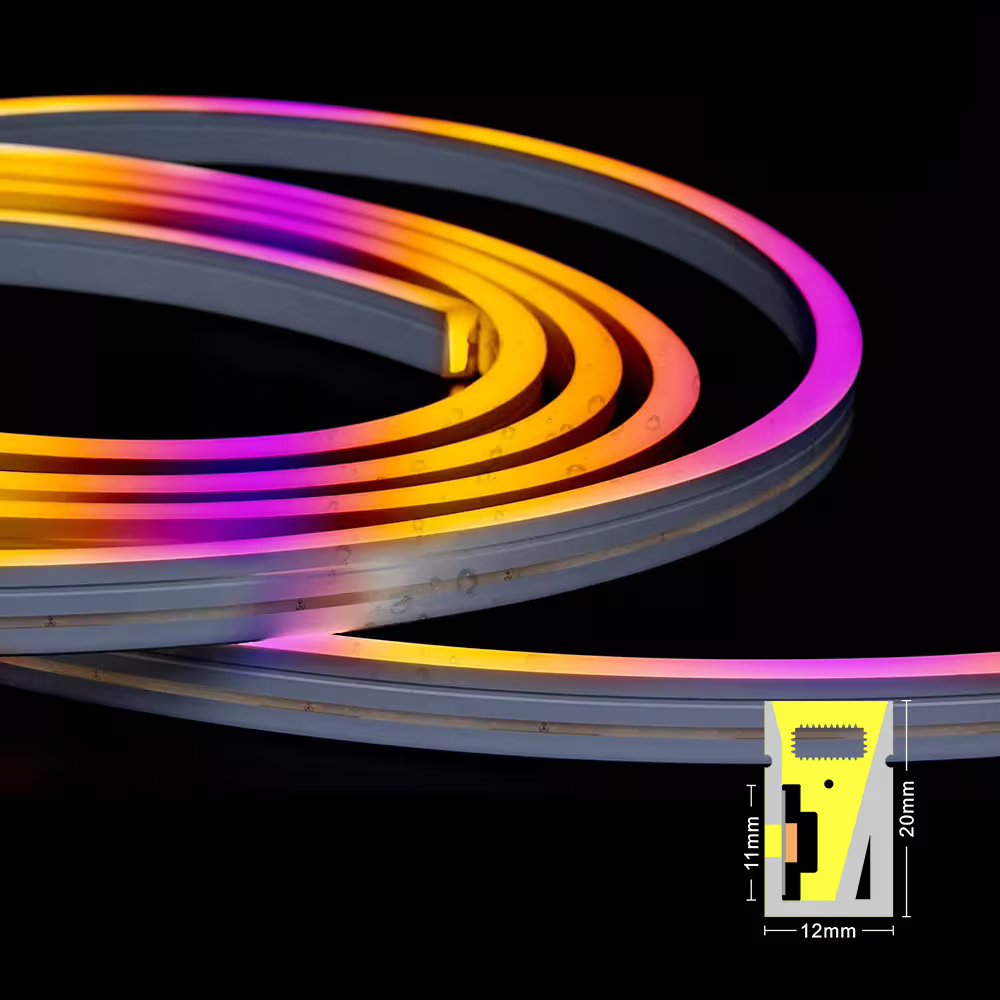
Side Bend S1220 Tira de neón LED direccionable de silicona para iluminación arquitectónica, de paredes y fachadas
Tensión de entrada: DC24V
Vatios: 12W/m@RGB, 19W/m@RGBW
Cantidad de LED: SMD5050 60LED/m
Temperatura de color: RGB/RGBW(2700K-6500K)
Tipo de señal: SPI/DMX512
Grado IP: IP65/IP67
Entrada de cable: Frontal
Diámetro mínimo de plegado: 100 mm
Longitud de corte: 100 mm
Longitud: 5 metros/rollo
¿Cómo controla DMX512 una tira de neón LED?
El controlador DMX512 envía comandos al sistema de tiras de neón LED a través de señales digitales (siguiendo el estándar RS-485); la señal es analizada por el decodificador y, a continuación, hace coincidir los datos del canal RGB de cada píxel LED de acuerdo con la dirección preestablecida para ajustar de forma independiente el brillo (nivel 0-255) y el color. Mediante la programación de escenas preestablecidas o el control en tiempo real para lograr gradientes dinámicos, parpadeo sincronizado y otros efectos aplicables al escenario, edificio y otras escenas, para asegurar que múltiples dispositivos trabajen juntos y anti-interferencias, las conexiones de control específicas se refieren al siguiente diagrama de circuito.
Esquema del circuito de conexión del sistema DMX512:
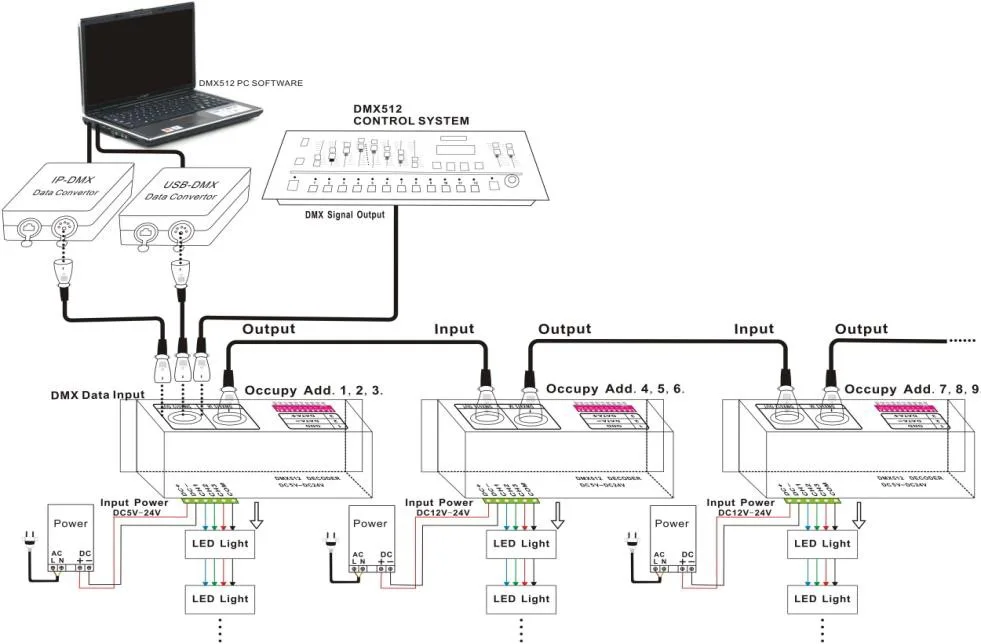
Selección del dispositivo de control DMX512
I. DMX512 Maestro
Los maestros DMX512 emiten una señal del estándar internacional DMX512/1990 a los decodificadores DMX512 para controlar la iluminación LED tenue de color único, color dual CCT, RGB, RGBW y RGB+CCT. Los dos más utilizados son los siguientes:
1. Controlador de panel táctil DMX512: Admite salida DMX512, con funciones incorporadas de atenuación, ajuste de la temperatura de color, control RGB/RGBW y capacidad para gestionar zonas (hasta 4 zonas), e integra múltiples modos dinámicos (como gradiente y salto). Su diseño de instalación tipo 86 es adecuado para escenarios comerciales o domésticos.
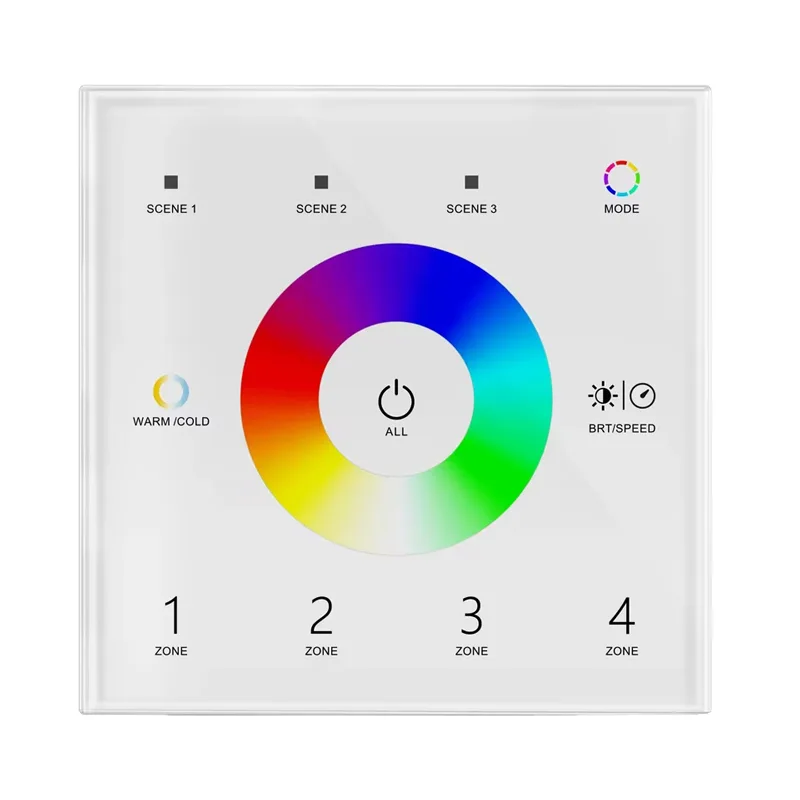
T15 Panel táctil DMX512 de montaje en pared
● El maestro DMX512 de 4 zonas y 1-5 colores del panel táctil también se puede utilizar como mando a distancia RF de 4 zonas y 1-5 colores.
● Salida de señal DMX, compatible con el protocolo estándar DMX512, compatible con decodificador DMX de cualquier proveedor.
Cuando se utiliza como mando a distancia RF, cada zona puede controlar a distancia varios controladores LED RF 2.4G, controladores de atenuación o lámparas inteligentes.
● Ultrasensible y de alta resistencia.
Descargar la ficha técnica del panel táctil DMX512 de montaje en pared T15
Precio: 24,98 USD/unidad
2. Control DMX512r: El controlador DMX512 es un dispositivo central utilizado para la regulación y control centralizado de equipos de iluminación escénica y efectos especiales de iluminación arquitectónica. Transmite instrucciones a través de señales digitales basadas en el protocolo DMX512. Puede gestionar varios dispositivos (como lámparas y motores) simultáneamente, ajustar con precisión parámetros como el brillo, el color y los efectos dinámicos, e identificar los datos de canal correspondientes para cada dispositivo mediante una dirección independiente. Admite la programación de escenas preestablecidas o el control en tiempo real para lograr la sincronización y automatización de los cambios de luz.
Los modelos K-1000C y K-8000C son adecuados para el control fuera de línea. Pueden utilizarse en una sola unidad o en cascadas múltiples para controlar más píxeles LED.
a. Si la lámpara principal tiene menos de 80.000 píxeles, se recomienda utilizar el controlador de píxeles DMX K-1000C.
b. Si la lámpara principal tiene entre 8.000 y 20.000 píxeles, se recomienda utilizar el controlador de píxeles LED DMX K-8000C.

II. Decodificador DMX-SPI
Convertir la señal DMX512 en un protocolo reconocible por las tiras de luz LED (como SPI). Por ejemplo, se utilizan chips como TM1803 y UCS512, correspondiendo cada chip al control del canal RGB de uno o más píxeles LED.
Es necesario asignar a cada píxel LED un código de dirección independiente, y el control punto por punto se consigue mediante la asignación de canales (por ejemplo, los píxeles RGB ocupan tres canales DMX).
Se puede controlar mediante la consola DMX, y se pueden conectar varios decodificadores DMX para aumentar la potencia de salida y conseguir todas las funciones. Varios modos de cambio. Además, el decodificador DMX también se puede utilizar como sincronizador. El controlador controla por separado el LED para conseguir un efecto de sincronización.
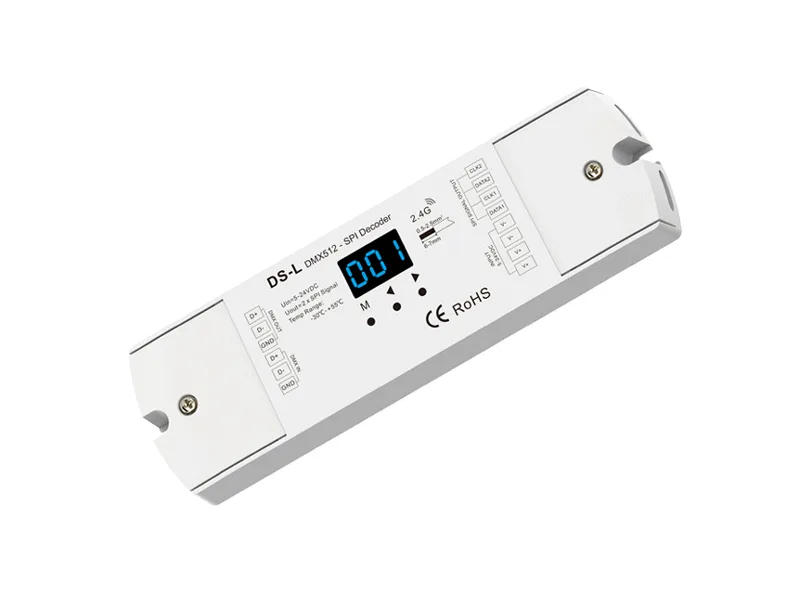
Decodificador DMX a SPI RGB RGBW y controlador RF
Modelo: CTL-RGB-DMX-DS-L
Tensión de alimentación: DC5V~24V
Consumo de energía: 1W
Señal de entrada: DMX512 + RF 2,4GHz
Señal de salida: SPI(TTL) x 3/4 canales
Modo dinámico: 32
Puntos de control: 170 píxeles (RGB 510 CH), máx. 900 píxeles
Dimensiones: L175 x An54 x Al27mm
Descargar hoja de datos de CTL-RGB-DMX-DS-L
Precio: 16,98 USD/unidad
III. Amplificador de señal DMX DA para tiras de neón LED impermeables
Se utiliza para ampliar la distancia de transmisión de señales DMX, soportando 1 entrada y múltiples salidas. Mejora la estabilidad de la señal mediante la tecnología de aislamiento fotoeléctrico y es adecuado para entornos electromagnéticos complejos o de larga distancia.
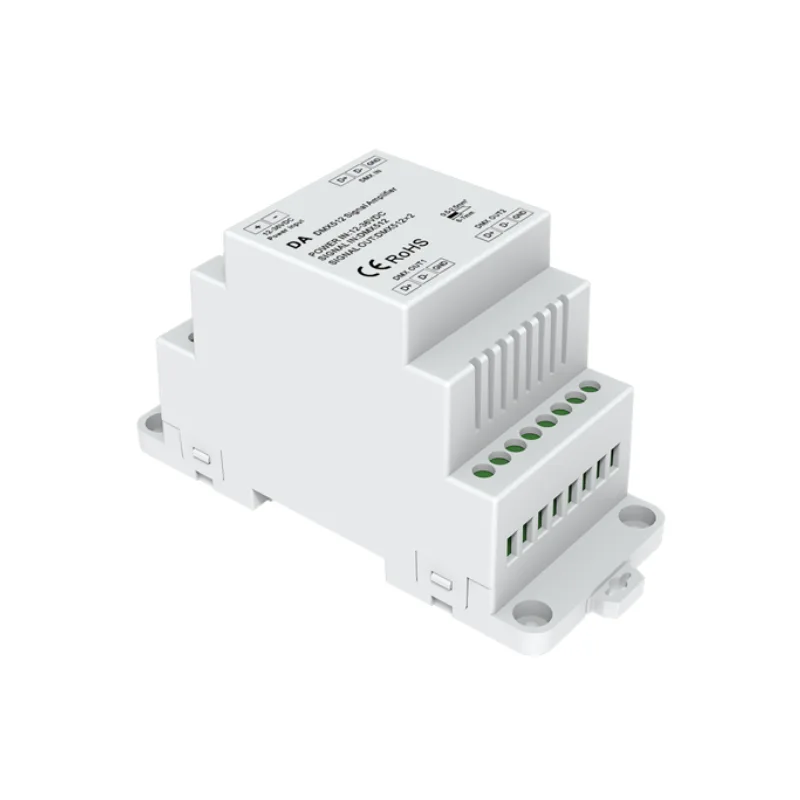
Amplificador de señal DMX DA
● Amplificador de señal DMX 512 de 2 canales.
● Una entrada de señal DMX512, dos salidas de señal DMX512. Dedicado a amplificar, distribuir y aislar la señal que proviene del equipo del sistema de iluminación DMX cuando se conecta al bus de DMX512(o RS-485).
● Realice la ampliación de la distancia de transmisión de la señal.
● Señala el control de salida de expansión; aumentar el amplificador de señal DMX (485) para distribuir el control multicanal.
Precio: 24,98 USD/unidad
¿Cómo configurar la fuente de alimentación?
Un sistema de tiras de neón LED DMX512 suele constar de varios segmentos luminosos, que necesitan reservar un margen en función de la potencia total de la carga y de los cambios dinámicos.
1. Cálculo de la potencia de carga total: P total = ∑ (potencia de sección luminosa única × número).
Potencia por sección de luz: Potencia de la tira de neón LED DMX512 por metro o por sección (como 5 W/m).
Ejemplo: Hay 10 tramos de cinta luminosa, cada tramo de 3 metros, con una potencia por metro de 8 W. Total = 10 × 3 × 8 = 240 W
2. Cálculo de la potencia nominal de la fuente de alimentaciónpotencia = P total × (1 + factor de seguridad) ÷ eficiencia energética + P (controlador DMX)
Factor de seguridad: Se recomienda tomar 0,2~0,3 (el sistema DMX puede tener frecuentes fluctuaciones de atenuación y corriente).
Eficiencia energética: normalmente 85%~95% (la fuente de alimentación conmutada es más eficiente).
Consumo del controlador DMX: normalmente 5~20 W (es necesario consultar el modelo específico).
Por ejemplo:
Carga total 240 W, factor de seguridad 0,3, eficiencia de la fuente de alimentación 90%, consumo del controlador 15 W:
Alimentación = 240X1,3÷0,9+15≈303+15=362W
Se debe seleccionar una fuente de alimentación ≥ 360W.
Fuentes de alimentación de marca (por ejemplo, la serie Mean Well XLG) para minimizar las interferencias de señal y los problemas de caída de tensión. Proporcione una tensión estable (normalmente DC12V o 24V) que se ajuste a la potencia de la barra de luces (por ejemplo, 12W/m@RGB).
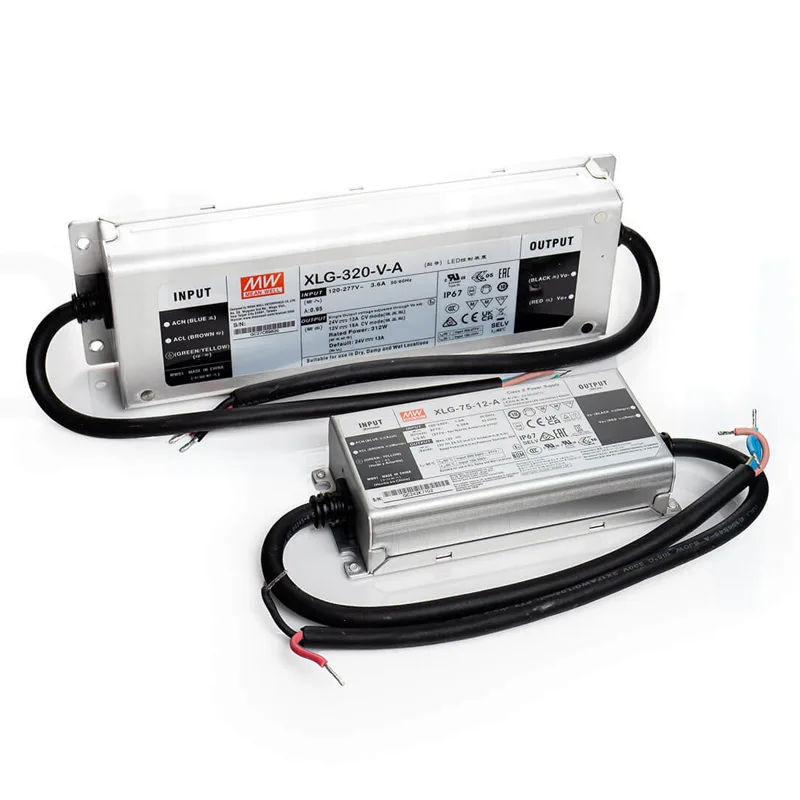
Fuente de alimentación LED de voltaje constante Mean Well Serie XLG IP67
- Modelo: XLG-75, XLG-100, XLG-150, XLG-200, XLG-320
- Tensión de entrada: AC100-305V
- Tensión de salida: DC12V/DC24V
- Corriente de salida: 5A-18A@DC24V, 3,1A-13A@DC12V
- Potencia: 75W-320W
- Eficacia: 89%-94%
- FP: >0,95
- Regulación: 3 en 1 regulable
- Clasificación IP: IP67
- Certificación: UL, CE, ROHS
- Garantía: 5 años
¿Qué es la caída de tensión?
En pocas palabras, caída de tensión es la pérdida de energía que se produce durante el flujo de tensión en un circuito cuando la corriente pasa a través de una luminaria LED. Este proceso es similar al flujo de agua a través de una tubería estrecha; la velocidad del agua se deberá a la fricción para producir una cierta cantidad de pérdida de energía. En el caso de las lámparas y linternas LED, la caída de tensión provocará una potencia de salida insuficiente, lo que afectará a la eficacia luminosa y a la vida útil de las lámparas y linternas.
El problema de caída de tensión de las tiras LED se produce cuando la tira LED está conectada a la fuente de alimentación, debido a la longitud del circuito y a la pequeña corriente provocada por la pérdida de tensión, el brillo de la tira LED no es suficiente o es desigual. Este problema es muy delicado para los usuarios que llevan mucho tiempo utilizando tiras de luz LED, por lo que deben buscar una solución.
Causas de la caída de tensión de las tiras de luz LED:
- Corriente más pequeña: la corriente de las tiras de luces LED suele ser pequeña, normalmente entre 0,02 y 0,03 A. Como resultado, se producen pérdidas de tensión incluso en líneas cortas y son más pronunciadas en las aplicaciones de líneas largas.
- Longitud de línea: En general, cuanto mayor sea la longitud de la línea entre el controlador y la tira de tiras de luces LED, más evidente será el problema de la caída de tensión.
- Cuestiones de calidad: La calidad de la tira LED también puede influir en los problemas de caída de tensión. Algunas tiras LED de baja calidad pueden tener problemas de caída de tensión debido a una resistencia interna excesiva o insuficiente, que puede aumentar la resistencia de la línea.
¿Cómo elegir los cables para la instalación de tiras de neón LED?
Sistema DMX512 fuente de alimentación de baja tensión (12V/24V DC), la corriente de línea es grande, el problema de caída de tensión es particularmente prominente, y hay que asegurarse de que la tensión final es estable.
Con el fin de garantizar la consistencia del brillo luminoso antes y después de las perlas de la lámpara y evitar el impacto de la caída de tensión en la tira de luz, por lo general podemos utilizar los siguientes métodos:
● Aumentar el diámetro del cable: reducir la resistencia de la línea (diámetro común del cable: 1,5 mm², 2,5 mm²).
● Fuente de alimentación segmentada: Al cablear largas distancias, divida la fuente de alimentación en varios circuitos.
● Mejora la tensión de la fuente de alimentación: si la caída de tensión en el extremo es demasiado grande, utiliza una fuente de alimentación con una tensión ligeramente superior (por ejemplo, diseña un sistema de 24 V en lugar de 12 V).
Para hacer frente correctamente a la caída de tensión, sino también no confiar en el conductor para aumentar el diámetro del cable, la necesidad de tener en cuenta el aumento del coste y la racionalidad del cableado. Podemos seleccionar correctamente los siguientes pasos para compensar aún más el problema de la caída de tensión.
Paso 1. Calcular la corriente de toma Calcular la corriente de toma
El sistema DMX suele dividirse en varios circuitos de control, que deben calcularse individualmente para cada circuito de carga:
I individual = P individual / V trabajo
Ejemplo: una sola carga de 3 secciones de la banda (3 m × 8 W/m × 3 secciones = 72 W), la tensión de funcionamiento es de 24 V.
I circuito único = 72/24 = 3,0A
Paso 2: Calcular la caída de tensión
R=ρ×(2L/A)
ΔU=I circuito simple×R línea
Parámetros clave:
ρ: resistividad del hilo de cobre tomada como 0,0172 Ω-mm²/m.
L: distancia unidireccional desde la fuente de alimentación hasta el extremo (unidad: metro).
A: Sección transversal del hilo (unidad: mm²).
2L: La longitud total de la ruta de ida y vuelta actual es 2L.
Por ejemplo:
Corriente de circuito único de 3 A, longitud de línea unidireccional de 15 metros, uso de cable de cobre de 1,5 mm²:
R = 0,0172 x (2 x 15/1,5) = 0,344 Ω
Caída de tensión: ΔU=3AX0,344Ω≈1,032VV
Tensión final: 24V-1,032V=22,97V (caída de tensión de 4,29%, conforme a los requisitos de ≤5%).
Caída de tensión admisible: normalmente se requiere que no supere los 5%-10% de la tensión de funcionamiento (caída de tensión del sistema de 12V ≤ 0,6-1,2V, sistema de 24V ≤ 1,2-2,4V).
Precauciones:
1. Separación de la señal y la fuente de alimentación: Se recomienda utilizar una fuente de alimentación independiente. Se recomienda utilizar una fuente de alimentación independiente para el controlador DMX y la tira de luces LED para evitar interferencias.
2. Cable apantallado: La línea de señal DMX necesita utilizar cable trenzado apantallado (por ejemplo, CAT5e) y mantener una distancia de más de 30 cm de la línea de alimentación.
3. Estrategia de alimentación segmentada: Cuando se instale en distancias largas, establezca una toma de corriente cada 20-30 metros para reducir la caída de tensión de un solo circuito.
4. Sincronización de alimentación: Cuando se conecten varias fuentes de alimentación en paralelo, asegure una toma de tierra común o utilice un módulo de sincronización para evitar que las diferencias de potencial interfieran con las señales DMX.
5. Medición de la tensión final: Utilice un multímetro para confirmar que la tensión final es ≥90% de la tensión nominal.
6. Prueba de estabilidad de la señal: Comprueba si la señal DMX parpadea o pierde paquetes debido a interferencias eléctricas.
7. Prueba de aumento de temperatura: Tras 1 hora de funcionamiento a plena carga, la temperatura de la superficie de la fuente de alimentación debe ser ≤60℃.
Para la instalación en exteriores, consulte el post: Soluciones de montaje flexible de neón LED para exteriores para arquitectos e instaladores.
Resumen
Controlado por DMX LED Neon Flex se ha convertido en la opción ideal para proyectos de iluminación arquitectónica gracias a su protocolo estandarizado y su gran capacidad antiinterferente.
La tecnología consigue un control preciso de la iluminación mediante el protocolo DMX512, admite la transmisión de señales a larga distancia (hasta cientos de metros) y la sincronización multinodo, y puede ajustar con flexibilidad el brillo, el color y los efectos dinámicos, lo que resulta adecuado para la decoración de fachadas de edificios, la iluminación paisajística y otros escenarios.
Adopta la tecnología de transmisión de señal diferencial para evitar eficazmente las interferencias electromagnéticas y admite la función de transmisión de punto de interrupción para mejorar la estabilidad del sistema. Las aplicaciones prácticas deben prestar atención a la configuración de direcciones y la planificación de líneas, como el uso del editor de direcciones DMX512 para configurar la dirección de las lámparas y farolas y, a través del controlador (por ejemplo, la plataforma Interact IoT), lograr una gestión centralizada y optimizar el consumo de energía y la eficiencia del mantenimiento.
Combinado con un control inteligente de atenuación y zonificación, el sistema de luces LED de neón DMX512 puede realizar un control preciso y un brillo uniforme a través de un diseño razonable, garantizando al mismo tiempo un funcionamiento fiable a largo plazo.
